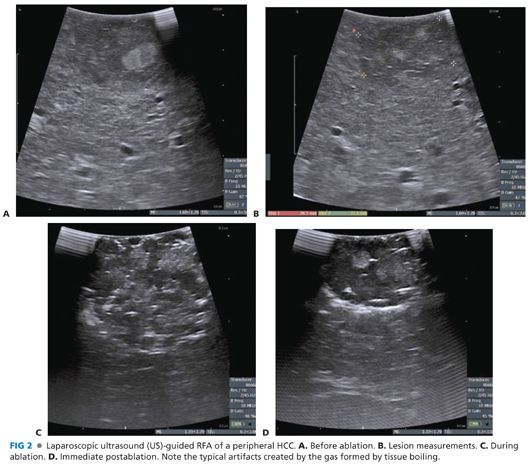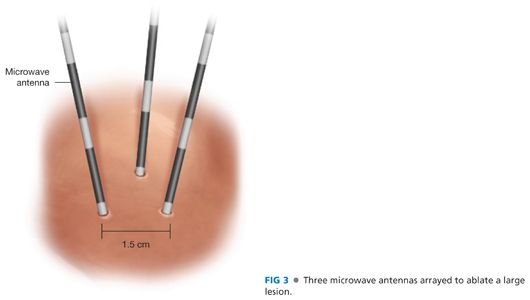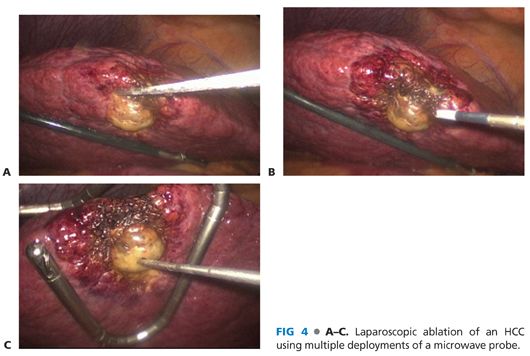
■ Ions in the tissue follow the direction of the rapidly changing current. This causes frictional energy to produce heat and coagulative necrosis.
■ As temperatures approach 100°C, changes in the physical properties of the tissue increase impedance and limit the flow of current (tissue desiccation due to evaporation of tissue fluid, charring, and the formation of electrically insulating gas between the electrode and the tissue due to boiling). This limits treatment of larger tumors.
■ MWA7
■ MWA uses electromagnetic radiation, much higher on the spectrum of electromagnetic radiation than RFA (usually in the range of 900 to 2,450 MHz) (FIGS 3 and 4).


■ Polar molecules in the electromagnetic field (mainly water) try to align in the direction of the current. As the direction changes constantly, continuous realignment causes friction and heating effect. Like RFA, the heat causes cell death by coagulative necrosis.
■ Unlike RFA, MW causes oscillation of water molecules in the entire field, so heat is uniformly distributed in the MW field throughout the activation. This achieves immediate and homogeneous heating and therefore faster tissue destruction.
■ Heat is conducted outside of that field, so the ultimate ablation size is the sum of the microwave field and the conductive heat zone.
■ The size of the microwave field is determined by the wavelength and the antenna design.
■ Within the microwave field, heat sink and current sink effects are not present. Outside the microwave field (in the conduction zone) there will be a heat sink effect, similar to RFA.8
■ MWA does not require point-to-point currents.
■ No current flows through the patient and no grounding pads are required.
■ IRE9
■ IRE is a new technique, based on nonthermal tissue destruction.
■ IRE is performed by placing electrodes into the tissue and delivering multiple high-voltage electrical pulses to induce pores in the lipid bilayer of cell membrane. This starts a process that leads to cell death.
■ IRE is not influenced by the heat sink effect.
■ Because the location of IRE activity is the cell membrane, acellular structures are preserved. Because hilar structures are wrapped in a fibrous sheet, they are protected. This allows for application of IRE to lesions in the vicinity of intrahepatic vital structures, unlike thermal ablation.10
PEARLS AND PITFALLS
Indications | ■ Resection is not an option. ■ The lesion is not too big. ■ The lesion is not adjacent to a heat sink or vital structure. ■ Ultrasound in cirrhotic livers is technically challenging. |
Technique | ■ Confirm appropriate probe placement with ultrasound—Record the images. ■ Confirm complete destruction of the lesion by ultrasound—Record the images. ■ Precoagulation prior to parenchymal transection (FIG 5) |
 | |
OUTCOMES
■ Factors influencing outcome include the following:
Stay updated, free articles. Join our Telegram channel

Full access? Get Clinical Tree








